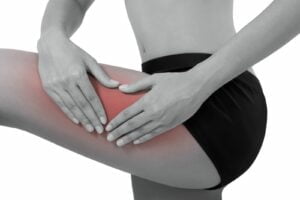Meralgia paraesthetica is a condition that causes tingling, numbness, and burning sensations in the outer thigh, often due to compression of the lateral femoral cutaneous nerve. If you’re tired of living with these discomforting sensations, traditional treatments might not be your only option. In this article, we explore the potential of physical therapy in managing meralgia paraesthetica symptoms and enhancing your overall quality of life.
Contents
Understanding Meralgia Paraesthetica

Meralgia paraesthetica, also known as lateral femoral cutaneous neuropathy, is a medical condition that involves the compression or irritation of the lateral femoral cutaneous nerve (LFCN). This nerve is responsible for providing sensation to the outer thigh.
Here’s a breakdown of the key aspects of meralgia paraesthetica:
Causes
The condition often arises due to compression or entrapment of the LFCN as it passes through the inguinal ligament (a ligament that runs across the groin area). Common causes of compression or irritation include:
- Tight Clothing: Wearing tight belts, pants, or other clothing that puts pressure on the inguinal area can lead to nerve irritation.
- Obesity: Excessive weight, particularly in the abdomen, can increase pressure on the inguinal area and contribute to nerve compression.
- Pregnancy: The increased weight and pressure on the pelvic region during pregnancy can lead to compression of the LFCN.
- Injury or Trauma: Direct injury to the pelvic region or surgery in the area can damage or irritate the nerve.
- Diabetes: Nerve damage (neuropathy) associated with diabetes can also contribute to meralgia paraesthetica.
Symptoms
The primary symptom of meralgia paraesthetica is abnormal sensations on the outer thigh, typically on one side of the body. These sensations may include:
- Burning: A burning or tingling sensation on the outer thigh.
- Numbness: Numbness or reduced sensation in the same area.
- Pain: Some individuals may experience pain, which can range from mild to severe and may worsen with movement or pressure on the affected area.
- Sensitivity: The skin on the affected thigh might become sensitive to touch or pressure.
Diagnosis and Medical Assessment
Before embarking on any treatment journey, accurate diagnosis is essential. Healthcare professionals employ a range of tests, from physical examinations to nerve conduction studies, to confirm meralgia paraesthetica.
This step is crucial in ensuring that you receive the appropriate care tailored to your condition.
Traditional Treatments
Traditional treatments for meralgia paraesthetica often involve medications that provide temporary relief. However, these medications may not address the root cause of the condition. This is where the promising avenue of physical therapy steps in.
The Role of Physical Therapy
Physical therapy plays a crucial role in the management of meralgia paraesthetica. The primary goals of physical therapy for this condition are to alleviate symptoms, improve nerve function, address underlying causes, and prevent future episodes. Here’s a more detailed look at the role of physical therapy in managing meralgia paraesthetica:
- Pain Relief: Physical therapists use various techniques to reduce pain and discomfort associated with meralgia paraesthetica. This might include manual therapy, soft tissue mobilization, and modalities like ice or heat to ease acute symptoms.
- Posture and Movement Correction: Incorrect posture and movement patterns can contribute to nerve compression. Physical therapists assess your posture and movement mechanics to identify any issues that might be exacerbating the condition. They then guide how to maintain better alignment during daily activities.
- Muscle Imbalance Correction: Imbalances in muscle strength and flexibility can contribute to nerve compression. Physical therapists design exercises that target specific muscle groups to restore balance and reduce stress on the affected nerve.
- Stretching and Flexibility Work: Gentle stretching helps release tension in muscles that might be contributing to nerve compression. By improving flexibility, you can reduce the strain on the nerve.
- Education and Self-Management: Physical therapists educate you about meralgia paraesthetica, its causes, and strategies for managing symptoms. This education might cover proper ergonomics, posture awareness, and techniques for self-care at home or work.
Customized Exercise Regimens
A customized exercise regimen for meralgia paraesthetica should be developed in consultation with a qualified physical therapist or healthcare professional who has experience in treating nerve-related conditions. The goal of the exercise regimen is to alleviate symptoms, improve nerve function, and address contributing factors. Here’s an example of what a customized exercise regimen might include:
1. Warm-Up: Begin each session with a gentle warm-up to increase blood flow to the muscles and prepare your body for exercise. This could involve light cardiovascular activity, such as brisk walking or stationary cycling, for about 5-10 minutes.
2. Stretching: Focus on stretching the muscles that might contribute to nerve compression or tension in the hip and thigh area. Examples of stretches include:
- Hip Flexor Stretch: Kneel on one knee, with the other foot placed flat on the ground in front of you. Lean your hips forward while keeping your back straight to feel a stretch in the front of your hip.
- Hamstring Stretch: Sit on the floor with one leg extended and the other bent. Lean forward at your hips while keeping your back straight to feel a stretch in the back of your thigh.
3. Strengthening Exercises: Engage in exercises that target the muscles around your hip and core. Strengthening these muscles can provide better support and reduce pressure on the lateral femoral cutaneous nerve. Examples of strengthening exercises include:
- Bridges: Lie on your back with your knees bent and feet flat on the ground. Lift your hips off the ground, creating a straight line from your shoulders to your knees. Hold for a few seconds, then lower back down.
- Clamshells: Lie on your side with your knees bent and legs stacked. Keeping your feet together, lift your top knee while keeping your feet touching. Lower it back down and repeat.
4. Nerve Gliding Exercises: Perform gentle nerve gliding exercises to improve the mobility of the lateral femoral cutaneous nerve. These exercises should be done under the guidance of a physical therapist to ensure proper technique.
5. Core Strengthening: A strong core can contribute to better overall stability and posture. Incorporate exercises such as planks, bird dogs, and pelvic tilts to target your core muscles.
6. Posture Awareness: Practice maintaining good posture throughout the day, especially during activities like sitting and standing. Your physical therapist can guide proper posture techniques.
Different Techniques of Meralgia Paraesthetica Physical Therapy

Physical therapy for meralgia paraesthetica employs a variety of techniques to address symptoms, improve nerve function, and address underlying causes. Here are some different techniques that might be used in meralgia paraesthetica physical therapy:
- Manual Therapy: Manual therapy involves hands-on techniques by the physical therapist to manipulate and mobilize tissues. Soft tissue mobilization, myofascial release, and joint mobilizations can help reduce muscle tension, improve blood flow, and enhance overall tissue health.
- Stretching Exercises: Specific stretches target muscles that might contribute to nerve compression. These stretches aim to improve flexibility, alleviate tension, and promote proper muscle function.
- Nerve Gliding Exercises: Nerve gliding, also known as neural mobilization, involves controlled movements that gently stretch and glide the affected nerve. This technique aims to improve nerve mobility, reduce adhesions, and minimize nerve irritation.
- Postural Training: Physical therapists assess your posture and identify any imbalances or habits that might contribute to nerve compression. They then guide maintaining better posture during daily activities to reduce strain on the nerve.
- Core Strengthening: Exercises that target the core muscles, including the abdominal and back muscles, can improve overall stability and support for the spine and pelvis.
- Gait Training: If altered gait (walking) mechanics contribute to meralgia paraesthetica, physical therapists can analyze your walking pattern and provide techniques to improve your gait, reducing nerve irritation.
Incorporating Lifestyle Changes

Incorporating lifestyle changes alongside medical treatments and physical therapy can play a significant role in managing meralgia paraesthetica. These changes aim to reduce the factors that contribute to nerve compression and improve your overall well-being. Here are some lifestyle adjustments that may help:
- Weight Management: Maintaining a healthy weight can alleviate pressure on the pelvic area and reduce the risk of nerve compression. If you’re overweight, working towards a gradual and sustainable weight loss plan under the guidance of a healthcare professional can be beneficial.
- Clothing and Accessories: Avoid wearing tight clothing, belts, or accessories that put pressure on the inguinal area. Choose clothing with a loose and comfortable fit to reduce irritation of the lateral femoral cutaneous nerve.
- Posture Awareness: Maintain good posture during daily activities, especially when sitting or standing for prolonged periods. Engage your core muscles to support your spine and pelvis.
- Ergonomics: Ensure that your workspaces are ergonomically designed to support proper posture. Adjust the height of your chair, monitor, and keyboard to minimize strain on your back and hips.
- Regular Movement: Avoid prolonged sitting or standing in one position. Incorporate regular breaks to stretch and move around. Simple movements like standing up, walking, or performing gentle stretches can help prevent nerve compression.
- Exercise Routine: Engage in a regular exercise routine that focuses on strengthening core muscles, improving flexibility, and promoting overall fitness. Consult with your healthcare provider before starting any new exercise program.
Conclusion
Living with meralgia paraesthetica can be challenging, but it’s not a battle you have to face alone. Physical therapy offers a beacon of hope, guiding you toward a life free from persistent tingling and discomfort. Don’t let this condition dictate your days—embrace the empowering journey of physical therapy and take the first step toward lasting relief.
Physical Therapy helps patients recover from pain. If you’re experiencing Back, Shoulder, Knee, Neck, Elbow, Hip, or Arthritis pain, a physical therapist at PhysioMantra can help: Book an online physical therapy session.



